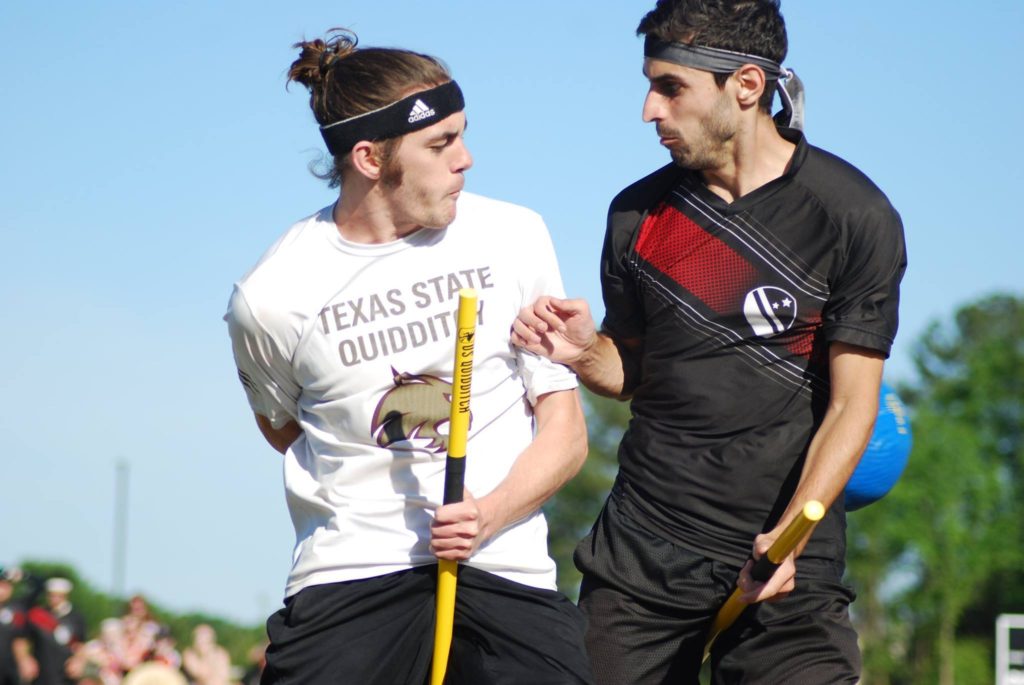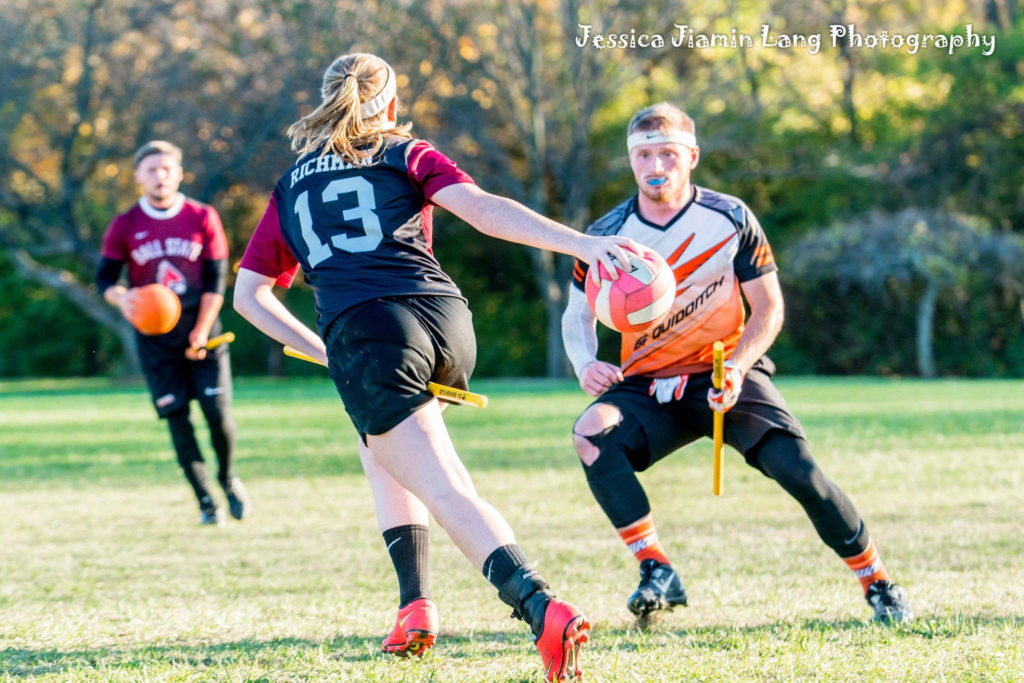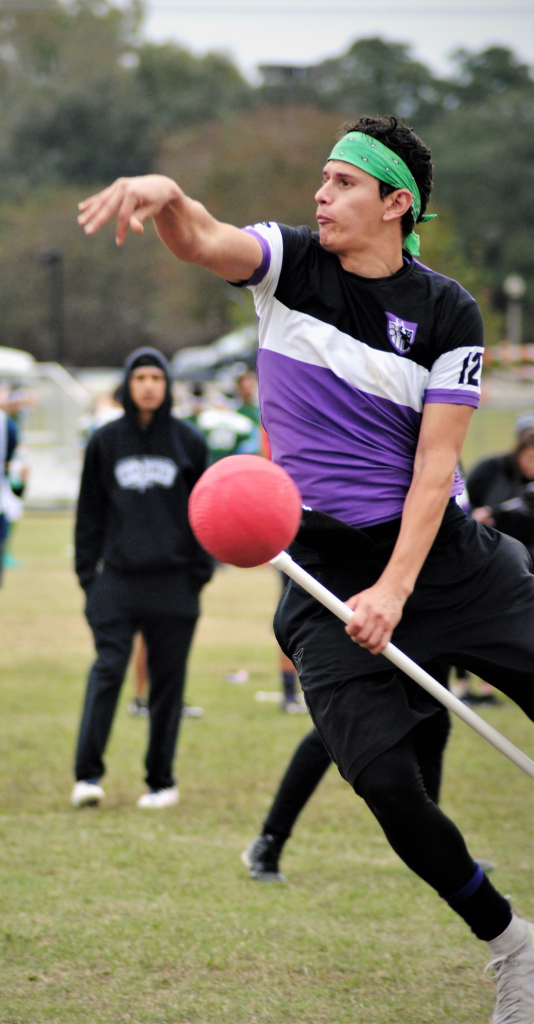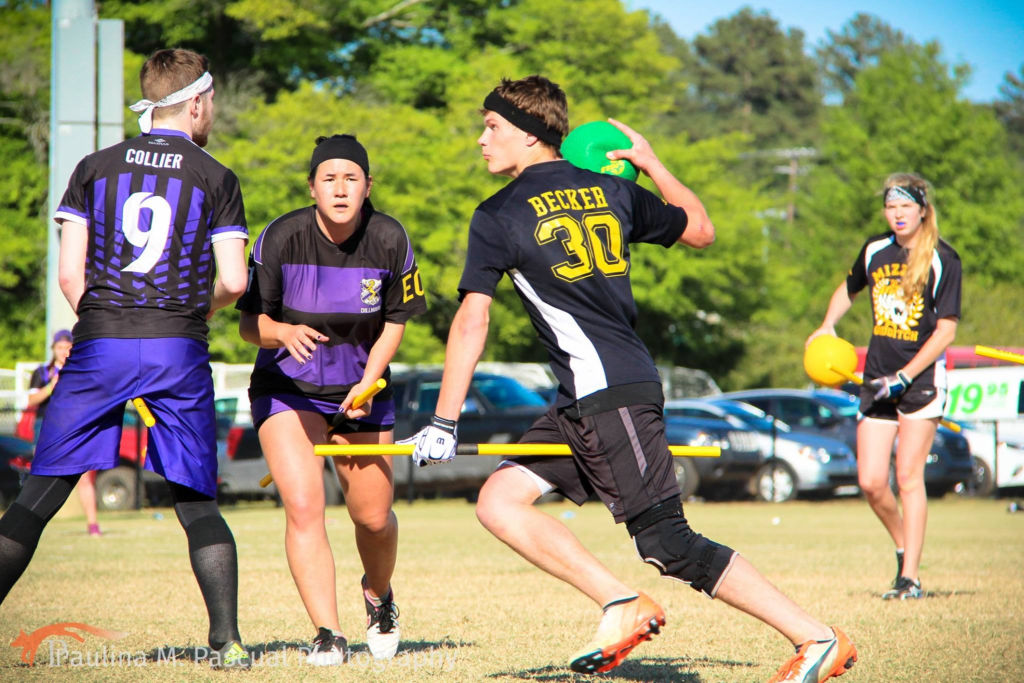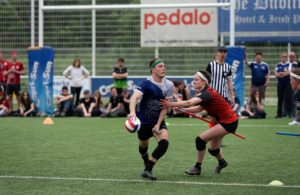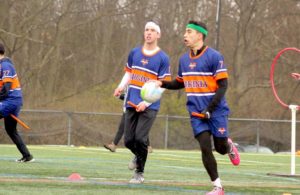- Rule, Britannia, no more?
- Unpopular Opinions: US Quadball Cup 2023
- Proven Contenders: University of Virginia
- Proven Contenders: Rutgers University
- Proven Contenders: University of Michigan
- Proven Contenders: Creighton University
- Different Perspectives: A Look Inside USA Ultimate
- Antwerp QC, Much of Belgian Core, Leaves Competitive Quidditch
Unpopular Opinion: US Quidditch Cup 10
In quidditch, we like our opinions to be popular. We hype the same players, back the same teams, and utilize the same surface-level analysis. The Eighth Man’s annual US Quidditch Cup Unpopular Opinion article seeks to break from that mold, with a series of takes about USQ’s major event—all of which are judged to be outside the norm of popular opinion.
Now in its fifth year, the Unpopular Opinion article has been the kind of mixed bag of surprising successes and embarrassing failures you could expect from the world of risk-heavy prognostication. We’ve had the highs of calling the University of Maryland’s World Cup 8 Final Four run and the lows of predicting a Lost Boys championship at World Cup VII. So far, we’ve gone 2-for-3 at World Cup VI, 6-for-9 at World Cup VII, 4-for-6 at World Cup 8 and an underwhelming 2-for-5 at US Quidditch Cup 9.
So what does US Quidditch Cup 10’s edition have in store for us? Let’s dive right in and find out.
No Room For New Blood in the Final Four
In the past seven US championships, 18-of-28 semifinalists were making their first appearance on the Final Four stage, including 12-of-16 teams in the past four years. Some of the greatest storylines in quidditch history have come from surprising bracket runs at nationals. Whether it was University of Minnesota in 2011, Bowling Green in 2013, Texas State University in 2014, University of Maryland in 2015 or Ball State University in 2016, these teams have left lasting impressions on the sport, and, in many cases, come to redefine their programs as national powerhouses.
This year, that will not be the case.
Among those 12 teams who have made the semifinals in the past four years is a veritable “who’s who” of top teams over the course of the 2016-17 USQ season. Ball State, Bowling Green, Lone Star Quidditch Club, Lost Boys Quidditch Club, Maryland, Quidditch Club Boston, Rochester United, University of Texas and Texas State are all teams with a previous semifinals run and the talent to make another one. Each of these teams, save Ball State and Lone Star, are pot one teams who are poised to win their pools and end up with a seed that gives them an easy run to the deep into Sunday, and even Lone Star as a pot two is the prohibitive favorite to run away with their pool as well.
Fans of Texas Cavalry, the Los Angeles Gambits, Arizona State University and Florida’s Finest may certainly object to this statement, but each of those teams has liabilities that could easily drop them from the running. Cavalry, in Pool 11, is once again placed in a “Pool of Death.” Although Cavalry enters as the favored team among The Warriors, University of Michigan, Tufts University and Illinois State University, the risk of Cavalry dropping a game in such a perilous pool is significantly higher than most other pot one teams. Last year, Cavalry was put in a similar situation and limped into bracket play with a 2-2 record, where they ultimately fell to Lone Star in the Sweet 16. The Gambits, while given a simpler path to win their pool, have shown weaknesses throughout their history in putting teams away. As a team that relies so heavily on their starting line, the Gambits will face increasingly difficult games on Sunday, and any slip up due to fatigue or strategy in their first three games will cost them a spot to the semis.
Florida’s Finest and Arizona State, while both officially undefeated, face even steeper paths to the semis. Losses to Gulf Coast Gumbeaux and Carolina Heat in tournaments that were deemed unofficial after the fact show that Finest will be vulnerable to mid-tier teams who can match or outplay their beaters. While they may win a rematch against these teams, they will need to play much better squads if they plan on making the semis—something they’ve yet to prove they can do.
Arizona State, on the other hand, has shown vulnerability in their inability to put mid-tier teams like the Long Beach Funky Quaffles and Northern Arizona University out of range this season. The addition of Lone Star to their pool will likely set them farther back than Arizona State will be able to adapt to.
While all of these teams are very good and should likely make the round of 16 or the quarterfinals, this is a year in which experience will win out, and only the teams who have been there before will show they have what it takes to make it back.
– Joshua Mansfield
The Pool of Death Will Prove Deadly for The Warriors
The last couple of years have been pretty a pretty rough go for my predictions. Last year featured ultra-compelling pool play after I predicted an all-time boring set of pool games. Two years ago, I predicted that the Swiss format would be seen as a success by most people, and, while I’d still argue it was a success, it’s certainly would be too much of a stretch to say that most people agree with me.
So I’m going back to my wheelhouse: namely, I’m picking on Michael Parada.
Three years ago at World Cup VII, I went 3-0 with my unpopular opinions, but by far my boldest was that the NYDC Capitalists, ranked No. 7 in The Eighth Man rankings at the time, stood a very real chance at failing to advance from their pool of death. Sure enough, the team literally did not survive day one, failing to make bracket play and disbanding the following summer.
I’m doubling down here, and I won’t even hedge this time: I don’t think The Warriors are going to advance past pool play.
The Mid-Atlantic runners-up have a phenomenal squad, but for the second time in three draws, the luck of pools has not been kind to them. Starting at the top, Texas Cavalry is a punishing top seed, one that I feel will comfortably take this pool and could easily push The Warriors out-of-range. The Warriors are 0-6 against The Eighth Man Top 20 this season, and I don’t see that changing here.
Their troubles, though, extend far beyond the top seed. They have the bad fortune to have drawn a physical Michigan team that seems to have an impressive knack for peaking at the national championships every year. The Warriors have struggled against physical teams this season—scoring 60 or less points in games against Rochester United, the BosNYan Bearsharks, and Texas State University—and struggled in SWIM situations—going just 3-5—leaving them ripe for an upset. Their fourth seed is a Tufts team that played highly-ranked BosNYan and RPI tight at regionals, who could easily have two of the three best players on the pitch in that match in David Stack and Devon Ramsey, and have already played The Warriors even in quaffle points in October while short-rostered. Finally, their fifth seed is a Illinois State University who is notorious for being able to drain all pace out of the game, which, if they can do that, could give Team USA seeker Jeffrey Siwek a chance to pull a shocking upset.
The schedule isn’t kind to them, either. Their first game is going to be that pivotal Tufts showdown that could easily determine who advances out of the pool. They follow that by playing a very-physical Michigan team that could leave them drained for Texas Cavalry. While it is possible a pace-depleted match against Illinois State could be excellent rest for them, they get no benefit from it, as it’s their last game of the day.
To be fair to The Warriors, there are plenty of paths for them to advance. While their most notable win of the season has been in double overtime against the same Rutgers University team that Tufts defeated, they have some very strong quaffle game showings: holding even with Texas State and only being down by ten points to Maryland. They should definitely be favored to win against Illinois State and Tufts, but once again, a strong Parada-captained team is in a nasty pool with very little margin for error.
– Kevin Oelze
The Great Lakes Will Rise Again
When all is said and done, three-quarters of the Great Lakes region will still be competing on Sunday at US Quidditch Cup 10. In fact, the region is even in position to put 7-of-8 teams into the 36-team bracket, but six would be enough to double the Great Lakes teams in bracket a year ago.
The Great Lakes overall is set up in a great position to make this a reality. The region has five pot three or higher teams, leaving them only needing to hold seed to make day two. Only the Southwest has more teams in the top three pots.
Ball State University, Bowling Green, Lake Erie Elite, Michigan Quidditch and Ohio State Quidditch are not all locks to make to bracket play, but each would be a surprise to be left out on Sunday. The sixth and seventh team will most likely be University of Central Michigan or Miami University Ohio. Each were quaffle points away from making brackets last year, are in easier pools this year, and are better teams than last year. Each will play three winnable games and have a great chances to compete Sunday.
Last year Central Michigan missed out in a three-way tie with UC Berkeley and University of British Columbia for the final spot in a pool with no wiggle room at the top with Lone Star and Maryland. This year, Central Michigan could potentially end as high as second in their pool.
The Los Angeles Gambits are a lock to make brackets, but their two losses this season bare resemblances to Central Michigan. Even if they don’t win, Central Michigan could work the point differential in their favor. Central Michigan will compete against Penn State University, Boston University and Sam Houston State University for the final two spots. Central Michigan played Penn State just weeks ago and lost 120*-30, but with a roster of only 13 a day after each team played a full tournament.
Central Michigan comes in more experience than last season with only three rookies on their team and this season have played 18 games against nationals-qualifying teams, more than the Nittany Lions and the Terriers combined. Sam Houston may be their toughest matchup outside of the Gambits but could be a blessing in disguise. This is a pot five team they can beat, but Sam Houston can also beat the teams above them—meaning their pool could come down to point differential, something both Great Lakes teams know about.
Miami does not have the same amount of experience as Central Michigan this year, but was in the obvious pool of death last year with Texas State and nearly made it out. This year, they have a much milder pool with Rutgers, Utah State University and University of Rochester. Miami comes into nationals with a record of 4-4 against out-of-region qualified teams, including three losses to No. 4 Rochester United.
After Texas State, Miami will face a Rutgers team who looked very beatable last weekend going to overtime against Macaulay and Utah State, who qualified out of one of the weaker regions, and a University of Rochester team who is a few steps below Rochester United. Miami proved they are right on the cusp last year going 2-2 in pool play, and like Central Michigan, they missed out on brackets due point differential against George Mason University. This year they won’t have to fight out of the pool of death, but Miami will fight out of the pot five spot—something that will prove challenging but doable.
Whether the number is six or seven—the Great Lakes will be heavily represented in bracket play.
– Tyler Walker
US Quidditch Cup 10 Will Lack a New Breakout Star
Since the World Cup VI season, widely believed to be the first year of the “modern era” of quidditch, the number of star players rising through the ranks has declined steadily each year. Just stop and ask yourself the question, “How many household names in quidditch rose to fame in the past year?” If you can’t think of even a single one, you wouldn’t be alone.
While there are a multitude of ways to gain national recognition, history shows us that there’s a few well-worn paths. You can be an integral part of a historically great team—like the legendary Texas team of World Cup 6. You can be a star player on a national contender team—like Tony Rodriguez of the Gambits. You can be recognized as one of the best at your position—like Max Havlin of Boston. You can ride a Cinderella story at nationals to fame—as Dan Daugherty of Bowling Green did at World Cup VI. Unfortunately, the lack of separation between college and community teams almost guarantees that none of these paths are now available to up-and-coming players.
As community teams continue to amass the most dedicated—and often most talented—graduates, the separation in talent between the average college team and the average community team grows further. These established community teams are often founded and led by star players who have the largest roles on field, and thus continue to improve at a faster rate than lower-tier community players. These star players are most often the best at their respective positions, and their usage rate as well as their tendency to advance far into tournaments and play the toughest schedules ensures that they continue their hold at the top of the player hierarchy. And the cycle continues.
The current situation in quidditch is akin to college athletes competing in a league with veteran professionals, albeit to a much lesser degree. While I am as big a fan of Cinderella runs and dark-horse underdogs as anyone, I don’t believe that any team is poised to make a run that shocks the quidditch community. I don’t believe a team or a player can stand up to the gauntlet of pre-existing elite teams and ride a shocking finish to national fame. And while I would be the happiest to be proven wrong, I don’t believe that new players can rise to fame until the college-community split, when players will be recycled every 4 years — giving previously unknown players a chance to stand in the spotlight.
– Kyle Jeon
The BosNYan Bearsharks are Final Four Bound
It’s safe to say that I have been pretty high on the newest community team in the Northeast this season. Discredited by many from day one for their laissez-faire approach to the sport, it quickly became apparent that, in quidditch, it matters little just how hard you try when you are significantly better than everyone else on the pitch. Now, six months after their inception, the Bearsharks enter US Quidditch Cup 10 fresh off a pair of unofficial wins over No. 1 Boston and No. 5 Rochester United. The BosNYan bandwagon is now boarding, and there are just a couple days left to hop on.
A year ago, Boston won a national championship on the back of a 14-player rotation. Five of those 14 splintered off onto the Bearsharks, who surrounded them with Leeanne Dillmann and Carli Haggerty—both top five non-male in quidditch at their position—Zack Gindes and Stanford Zhou—the heart of a New York University squad that was within inches of a Northeast Regional Championship in 2014—and CJ Junior—who worked with much of the BosNYan core during Emerson College’s Final Four run at World Cup VII.
This team is physically large—perhaps the biggest team ever put together outside of the Southwest. David Fox, Tyler Trudeau, Dom Bailey and Gindes are all more that capable of making hit after hit. Fox’s length and size give him the ability to take off-ball chasers completely out of the game. Haggerty is the tallest non-male chaser around, and she uses it to her advantage, consistently creating mismatches on the offensive edge. And all of that size doesn’t even mention Team USA’s Julia Baer, who is deadly with the ball in her hands behind the hoops.
Of course, you can only get so far in the quaffle game, and the Bearsharks have just as much to offer in the bludger game. Kyle Jeon and Dillmann are as impressive of a beater combination as you will see this weekend, but the addition of Zhou, who can spell Jeon and allow the team to play a two-male set at a high level, takes this beating core to a new level. All three are also known for their snitch-on-pitch play, giving Fox and Trudeau, both experienced at seeker, all the time they need in close games.
The team also drew about as perfect of a pool as they could have hoped for after dropping out of Pot One because they had to play in two regions in one day in order to qualify for the tournament. UC Berkeley, Tribe and the University of Virginia should all be severely overmatched by the pure athleticism and talent of the Bearsharks, who, excluding this past weekend when a seven-player BosNYan side lost to Boston University, have yet to be kept in range by a team outside The Eighth Man Top 20. That leaves a game against Bowling Green, who was exposed two weekends ago by the physicality of Michigan and who should find the Bearsharks to be a nightmare matchup. Jeon, Zhou and Dillmann are more than capable of neutralizing the two-male beater set of Max McAdoo and Max Portillo, and from there it’s going to be all about making no-bludger drives and stops, a game BosNYan is more than happy to play.
The Bearsharks could easily go through pool play without a single SWIM situations, grabbing a top seed going into day two. From there, they have the experience—eight of their players have played in at least one USQ championship Final Four match and two have played in two—physicality and snitch-on-pitch talent to make a deep run. Barring a matchup with Q.C. Boston or Lone Star in the Elite Eight, the Bearsharks are unlikely to be run out of range by just about anyone.
The BosNYan carefree facade blanketed the team’s entire season, but with just two days left to play, expect it to fall away quickly in Kissimmee. Only two days of the USQ season truly matter, and this team knows that better than anyone. Look for the Bearsharks to tie their ears back, extend the playing time of their stars, and make a run deep into Sunday.
– Ethan Sturm
The West Will Be Gone By Early Sunday
The last time the USQ’s championship came to Kissimmee, Fla., the West put three teams into the Elite Eight, with juggernaut UCLA supplemented by unexpected runs from Northern Arizona University and the Lost Boys. However, in the three championships since World Cup VI, only three more West teams have made a quarterfinal run: two trips by a Lost Boys team led by Alex Browne—who alone has made four Elite Eights—and one by Arizona Quidditch Club in its only year of existence. And as we return to Kissimmee, four years later, Browne is gone, and the likelihood of a West squad trip to the Elite Eight is gone with him.
Before we get to the obvious West contender for the quarterfinals, let’s write off some of the other top West squads. This year’s Lost Boys squad is far removed from the glory days of their phenomenal 2013-15 run and has had worrying performances in losses to Anteater Quidditch and by being kept in-range by UCLA, the Long Beach Funky Quaffles, Utah State and the Fighting Farmers on multiple occasions. No, none of those teams are below average, but a legitimate Elite Eight team shouldn’t be kept in-range by that group with such regularity. Doing so is just begging for an early bracket upset.
The second West contender, West Regional Champion Arizona State University, has had similar problems taking average teams out-of-range. Notably, Arizona State has struggled to score consistently, famously only scoring twice before the snitch came on pitch in their regional semifinal win over the Lost Boys.
The team the Sun Devils beat in the regional final is everyone’s favorite to make a deep run out of the West: the Gambits. So what is holding back one of the most-talented teams in the country—with arguably the most-talented individual in Rodriguez—motivated by a regional final loss and back-to-back seasons ended by scheduling annihilating their stamina, who also seem to have drawn a gift of a pool?
Easy answer: themselves. The Gambits have repeatedly shown that they struggle mightily when playing long matches, and infamously gave up a 40-point lead during snitch-on-pitch play in the West Regional final—the third time they’d lost a SWIM game after being out-of-range in the past two years. Personally, I hope they finally use their latest collapse to learn how to effectively manage the game, as the Gambits were my preseason pick to win the title. But this article is for unpopular opinions, so how is this for a prediction:
The Gambits cap every pool play game, take the No. 1 overall seed in the bracket, and become the second No. 1 seed in two years to fall in the Sweet 16 to an intelligent, beater-savvy team with an above-average seeker. You might think I’m making a team up out of thin air, but here’s a fun list of teams ranked between No. 8 and No. 20 in our media rankings that fit that description:
- University of Missouri
- Arizona State University
- BosNYan BearSharks
- The Warriors
- Gulf Coast Gumbeaux
- RPI
- Ball State University
I’m confident that a date with any of these teams in the Round of 16 will mean an end of the the Gambits, and, by extension, the West, at US Quidditch Cup 10.
– David Hoops
No, Tyler Walker, It Will Be the Midwest that Will Rise Again
Since the World Cup VI season, Great Lakes teams have performed better on the national stage than their Midwest counterparts. The current Great Lakes region has sent 11 teams to the Sweet 16 in the past four national championships, while the Midwest has managed just two—leading to a perception of the Great Lakes as a whole is a stronger region than the Midwest. While that may still hold true for the overall depth of the regions, the Midwest is setup to have a better nationals performance this time around.
Both Mizzou and Bowling Green look to be in good positions to make the Sweet 16. Both teams have great ball carriers in Daugherty and Jacob Parker; top beaters in Max McAdoo and David Becker; and reliable seekers in Sam Roitblat and Dominic Stelzer. However, what sets Mizzou apart is their depth at chaser. Mizzou can run out multiple chaser lines that can all step up and make hits in no-bludger situations, with Bowling Green having to rely largely on Zack Conkle for any physical presence. Mizzou is a more complete team and drew a pool which will play well into their strengths. That pool should set Mizzou up with a high seed and a clear path to at least the quarterfinals. With a huge reliance on Daugherty at both keeper and beater, along with a more rigorous day one schedule, Bowling Green runs a larger chance of losing a game early on in bracket play than making another Elite Eight run.
Outside of that, Lake Erie Elite, Ball State and the University of Kansas are the only other teams with realistic chances at making the Sweet 16. Kansas has fallen off the national radar the past few years, but they have a deep and talented beater line which has gone toe-to-toe with Becker on multiple occasions, along with a physical quaffle line. While drawing the No. 1 team in the nation is never a good pool draw, their other matchups seem favorable for the team getting a fairly good seed going into bracket play. Intense games with Mizzou have prepared the team for the atmosphere of bracket games, and make them a solid dark horse contender to make the Sweet 16.
Ball State still hasn’t recovered from the losses of Tyler Walker and Blake Fitzgerald to graduation last year and didn’t get any favors in their pool draw. A rematch with a Texas team looking for redemption and a UNC team with Kyle Bullins back could easily mean a 2-2 finish on Saturday. With a tough matchup after that ranking, the Sweet 16 will be a tough sell. While Jason Bowling can still get hot at any moment, he’ll struggle without Walker’s beater play to give him time to work on a snitch.
Lake Erie Elite has a better pool matchup than Ball State, but may be stymied by an issue the Cardinals don’t have: a lack of a clear-cut seeker. While they can throw different options at the snitch, they don’t have a set number one option to send out. Even with the physical presence of their former Michigan players, the lack of play time as a complete team and a top seeker leaves the team to be ripe for an upset before the Sweet 16.
Year in and year out, Great Lakes teams have made runs at nationals on underrated beating and the ability to find great seekers. That script remains mostly the same, but the teams enter this year with larger holes than before. The Great Lakes has consistently been the better half of the original Midwest, but look for that to change this nationals.
– Austin Pitts
There Will Be a College-Only Final
It seems that every year, the quaffle lineups of top community teams are even more loaded with talent. The best quaffle players, year after year, seem to overwhelmingly come from community team rosters—and yet the position of beater is very, very much dominated by college teams. Even with Team USA beaters Havlin, Walker and Michael Duquette all playing on community teams this season, we have seen the emergence of numerous elite beaters on the college stage, including the Texas’s Eddie Molina and Hallie Pace, RPI’s Mario Nasta, Texas A&M’s Harris Coleman, Texas State University’s Jackson Johnson, Mizzou’s Becker, and Bowling Green’s McAdoo.
Many top community teams simply do not have a strong enough beater to compete with the cavalcade of college beaters listed above, making a bracket matchup with any of those team a nightmare. Sure, a few of these college teams with top-notch beating don’t have an elite seeker—but neither do community teams. Lone Star has yet to find a clutch seeker and ranks 52nd among teams competing at nationals in both the average time it takes them to grab a snitch (301 seconds) and their SWIM record (33.33 percent). There is a myth that an elite snitch-on-pitch beater can make up for the faults of a weak or average seeker. But if that were the case, then Team USA would have won the past World Cup.
Perhaps only Boston has the right combination of elite beating and seeking to be confident in snitch-range situations against these top college sides. But Boston lacks depth to put top teams out of range, and showed their over-reliance on Havlin when they lost two game at the unofficial Cat City Invitational without him. Boston’s deceptive strength lies in the absolute lack of elite seekers Boston has faced in SWIM situations in the past two seasons, during which their only loss came when Margo Aleman grabbed a game-winning snitch in a single attempt.
But Boston will not have the luxury of avoiding top-notch seekers in this year’s bracket. Texas State’s dual threat of Steven Gralinski and Austin LaFoy is deadly. Mizzou’s Stelzer has turned a 4-10 SWIM record last year for the team into a 6-2 one this year. And despite not having a “star” name as a seeker, Texas’s seeking rotation has pulled them towards an impressive 8-3 record in SWIM situations.
Put simply, top colleges should be able to hold their own against the top community teams. Texas Cavalry’s signature style of play has been answered by colleges on multiple occasional already, with both Texas and Texas A&M holding 30-point leads during snitch on pitch against the team. The era of a hyperdominant community team—or a hyperdominant college team, for that matter—is over, and the finalists for US Quidditch Cup 10 will definitely have to get through multiple snitch-range games in bracket play.
In short, buckle up for a record number of in-snitch range games, a situation where the top college teams should have an edge. As such, it is highly likely, that despite the community team dominance this year, the finals will be contested between two college teams.
– We Breathe Quidditch

